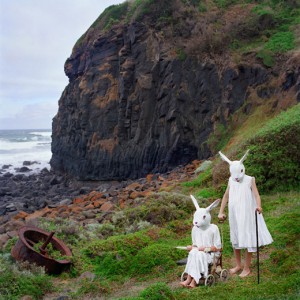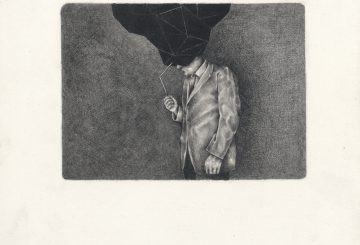Please welcome the debut of The Art Life’s newest contributor Isobel Philip who takes up the role of Sydney Editor-at-Large and reports on the spookiness of Polixeni Papapetrou’s recent show…
Pigment print, 105 x 105cm.
I was quite aware, on walking through Polixeni Papapetrou’s exhibition Between Worlds at Stills Gallery, that I had entered a kind of liminal space. This awareness was not so much a consequence of Papapetrou’s implicit thematic intention, as Susan Bright outlined it in the catalogue essay, but was rather triggered by the tone of the images themselves. Bright discusses how Papapetrou’s photographs of children wearing over-sized fake animal heads portray childhood as a fragile and in-between state, which she relates to the way children have become hybrid and fragmented figures in contemporary culture and media – yet such things were far from my thoughts as I wandered through the room. Indeed, without the catalogue essay that theme would have been lost on me – I wasn’t even initially aware that all the figures were children.
I found her surreal and staged photographic tableaux somewhat disquieting – and yet very tenderly beautiful at the same time. Each image is defined by tension; the tension between the real figure and the synthetic mask, but also between movement and stasis. The false heads seem so alien, so very other, to the small bodies they sit atop – almost as if they exist in an entirely different visual field, even though the figures’ posture and the colours of their clothes correspond to the head worn. I was continually struck with the sensation that I was looking at two very distinct and separate images in the one instant, and that the scene in the photograph before me was something of an embedded collage. Those plastic and static heads operate against the bodies that wear them, but retain traces of life and movement; the rabbit in the wheelchair in The Loner with the curled-up toes is palpably fragile, and likewise, the gorilla in The Caretaker recoils away from the vibrant green plant with one hand gripping her knee and seems delicately vulnerable. The scenes appear both staged and impromptu, navigating the space between the real and the unreal.
Pigment print, 105 x 105cm.
It was this cohabitation of the real and unreal that I found disquieting, and yet powerfully seductive too. This sense of disquiet, and also seduction, was compounded by the eyes of those hybrid figures. Wide open they stare at you straight on – penetrate you – yet with a very vacant and absent stare. It is not the eyes of the figures that establish the image’s emotive register or tactility, but rather the peripheral limbs; those toes, that hand. The eyes, on the other hand, disclose a hint of madness. A similar hint of madness to the one I’ve always felt looking at the eyes of Goya’s horses. Such eyes, I thought, couldn’t possibly belong to children. Perhaps this is why I didn’t initially make the thematic connection, even though several photographs overtly reference fairy tales and deal with childhood allegorically, most noticeably in The Harvesters where three little pigs are out collecting hay.
The space occupied by these figures, this between world, is hyper-real. While we are all familiar with natural settings of these scenes, which shift from the bush to the coast to the mountains, they become here, because of the subtly distorted colours, distinctly otherworldly. This is what captivated me. Not any attempt at social commentary, but the way the photographs gently oscillate between the known and the unreal. An oscillation that occurs within, or rather creates, remarkably striking images.




This is a really great piece on a show that had me a bit bamboozled. Well done Ms Philip.
Pingback: Rabbit in a Wheelchair | isobelparkerphilip.com
Pingback: Rabbit in a Wheelchair | Isobel Parker Philip